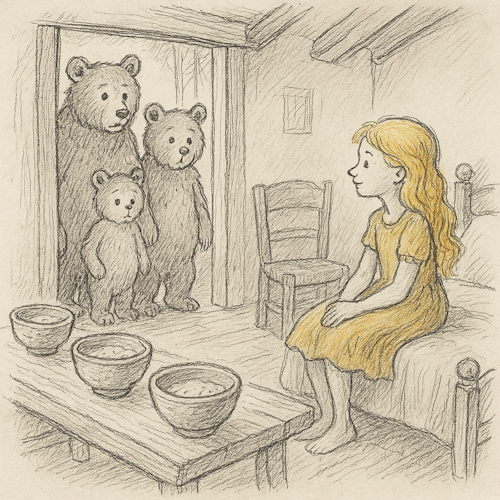Goldilocks & The Three Bears
Illustrates Right-Fit Planning, Iterative Discovery, Adaptive Expectations
In Agile environments, teams often struggle to find the right balance between too little and too much. Planning too far ahead can lead to waste, while not planning at all creates chaos. Similarly, solutions that are too rigid or too vague prevent real progress. The Goldilocks principle - not too hot, not too cold, but just right - offers a simple metaphor for the kind of adaptability Agile teams must embrace. This classic English fairy tale1 highlights the value of experimentation, awareness, and calibration, all of which are key to iterative delivery and product discovery.

Once upon a time, a curious girl named Goldilocks wandered into the forest and discovered a cozy house that belonged to three bears. Inside, she found three bowls of porridge. One was too hot. One was too cold. One was just right. She then found three chairs. One was too hard. One was too soft. One was just right. Later, she lay in three beds. One was too big. One was too small. One was just right.
Goldilocks never planned to intrude. She simply explored, tried things out, and learned from how each one felt. When the bears returned and found her, they were surprised, but also amused. She had discovered what suited her needs not by guessing, but by trying, learning, and adjusting.
Lessons Learned
Iteration Reveals Fit
Goldilocks did not assume she knew what was best before entering the house. She tested options. Similarly, Agile teams use short feedback loops, like Sprints and MVPs, to inspect and adapt. Fit is not decided in planning meetings. It is discovered through use.
Too Much Is as Dangerous as Too Little
In product development, over-engineering wastes effort while under-engineering creates frustration. Goldilocks reminds us that both extremes fail. Teams must find the balance that meets the moment, not a theoretical ideal.
User Experience Cannot Be Assumed
Each item in the bears' house had a different feel. Without trying them, Goldilocks would not have known what worked. Agile teams often assume users will like what is built. In reality, usability, performance, and value are confirmed through feedback, not assumption.
Adjustment Is Not Failure
Goldilocks did not get it right the first time. She learned from what didn't work. In Agile teams, a failed experiment is still progress if it improves understanding. Teams must be free to course-correct without shame.
Context Changes What Is "Just Right"
What fit Goldilocks may not fit someone else. In Agile work, team velocity, product design, or process maturity may differ project to project. There is no universal “just right”, only what works now, in this context.
Coaching Tips
- Reframe Planning as Calibration: Use Goldilocks to help teams shift from predicting the perfect plan to discovering the right fit through iteration and feedback.
- Make Retrospectives relatable: Ask, “Where did we go too big? Too small? Just right?” This invites reflection without blame and supports continuous improvement.
- Support Product Owner discovery: Remind POs that even Goldilocks had to test all three options. Encourage small experiments in scope, design, and delivery.
- Challenge perfectionist thinking: When stakeholders demand certainty up front, use this story to highlight the value of learning through exploration, not rigid execution.
- Normalize Research and Spikes: Goldilocks wasn't inefficient. She was learning. Reinforce that spikes, prototypes, and discovery work are part of healthy Agile flow.
The tale of Goldilocks and the Three Bears is more than a children's story. It is a parable about finding balance through experience. Agile teams thrive not by getting everything right on the first try, but by embracing discovery. The path to value is rarely straight. It is made clearer through small experiments, feedback, and willingness to adapt. Agile coaches can use this parable to encourage resilience, humility, and thoughtful calibration in the face of uncertainty. What matters most is not being perfect. What matters is learning what works.


